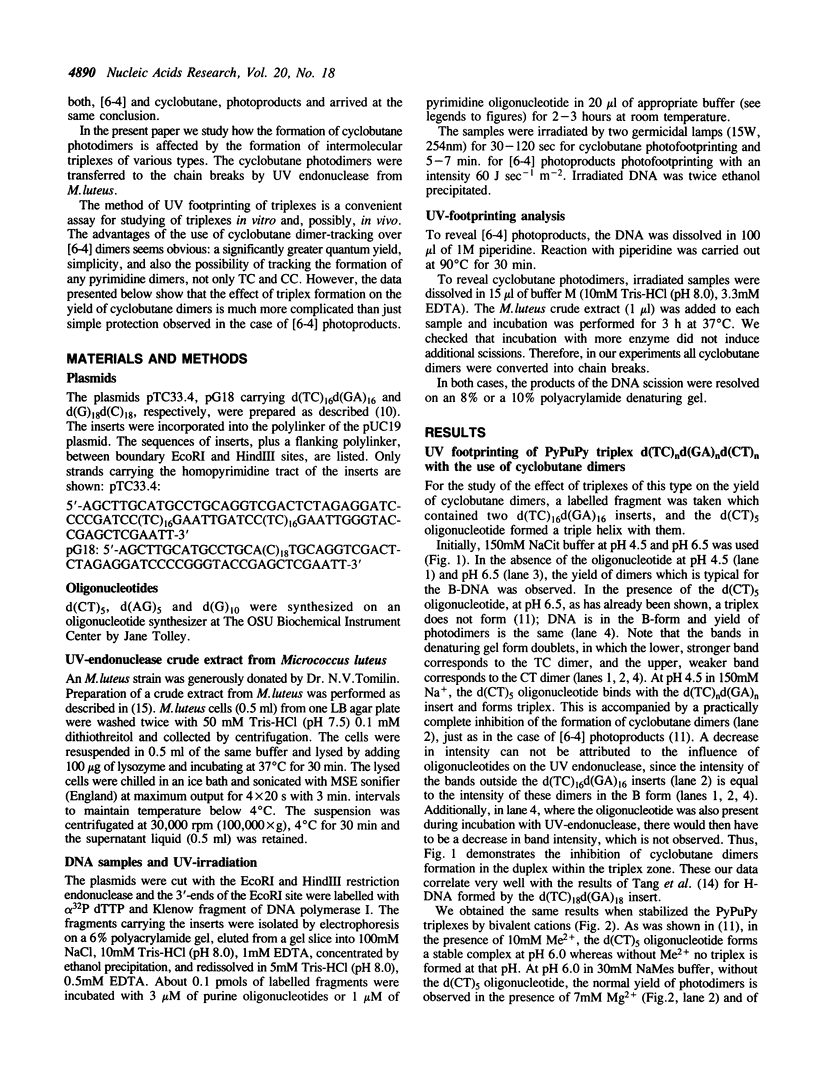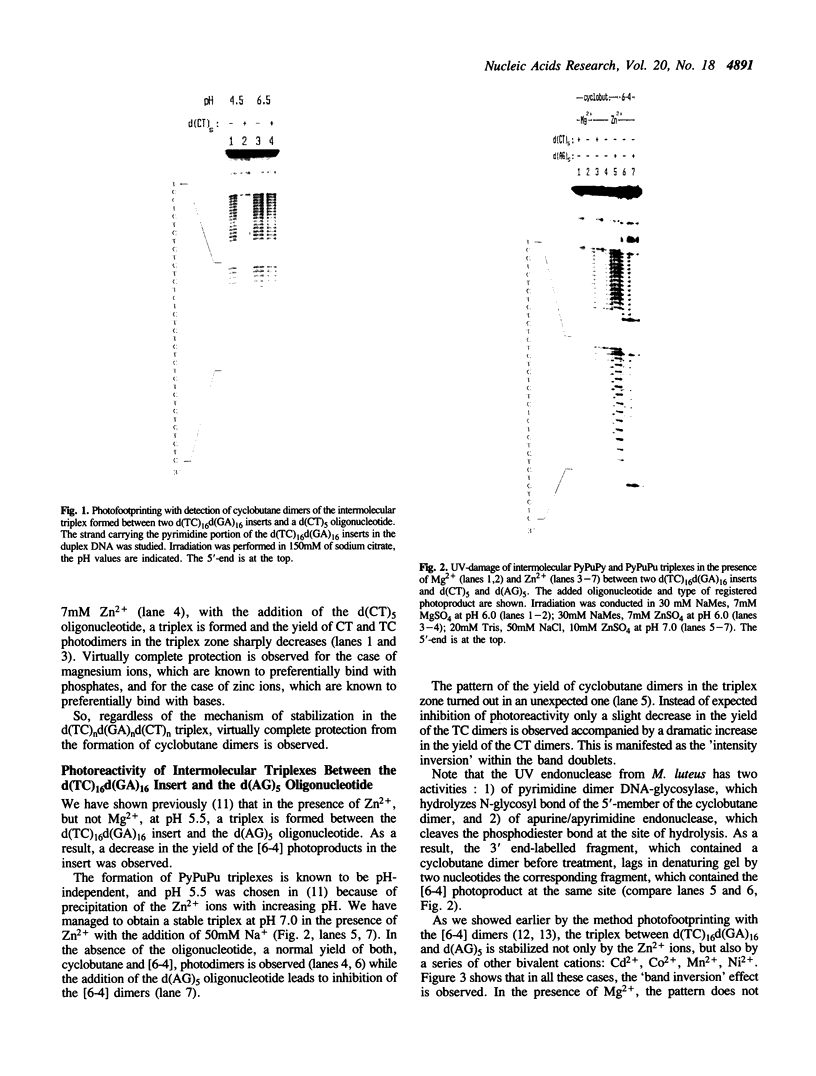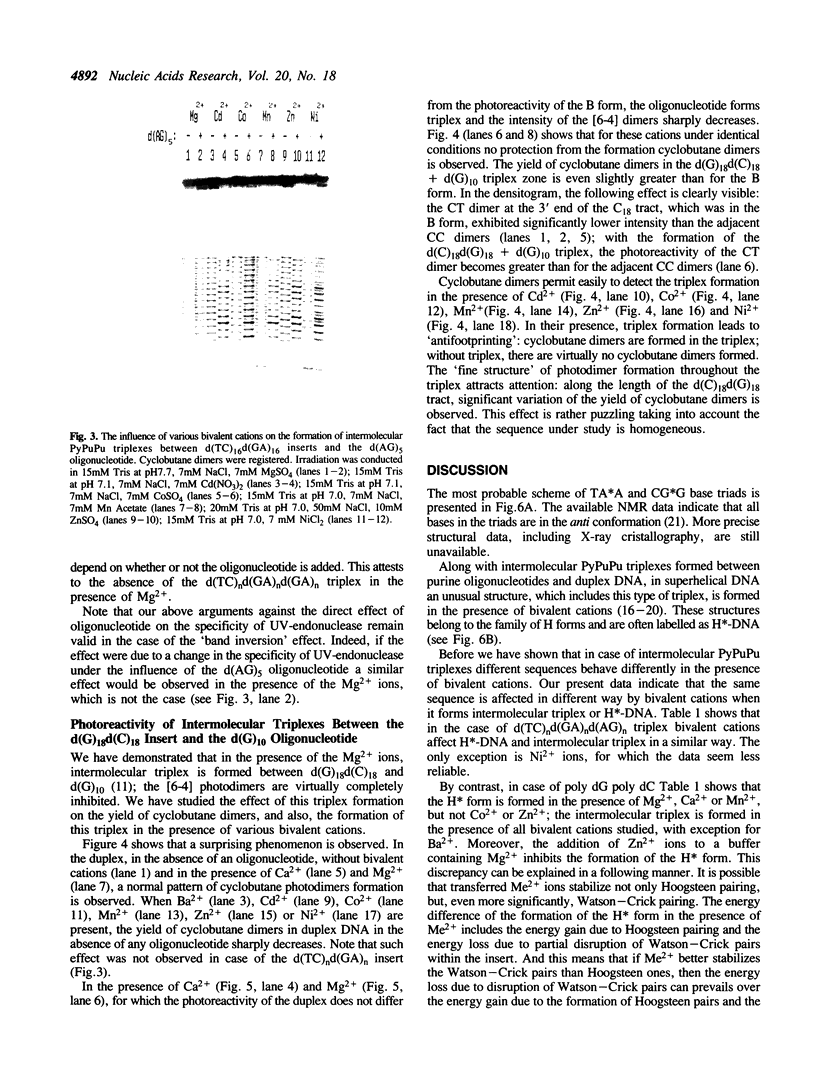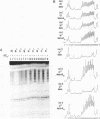Abstract
We have studied the effect of intermolecular triplexes formation on the yield of cyclobutane photodimers in DNA. DNA duplex within the pyrimidine-purine-pyrimidine triplex d(TC)nd(GA)nd(CT)n is protected from the formation of cyclobutane photodimers in the case of the stabilization of this triplex by acid pH, and in the case of supplementary stabilization by Mg2+ or Zn2+. We have studied pH-independent pyrimidine-purine-purine triplexes stabilized by bivalent cations. In such triplexes, the protection from the formation of [6-4] photodimers is observed, whereas the protection from cyclobutane dimer formation does not take place. The formation of the d(TC)nd(GA)nd(GA)n triplex leads to an inversion of the intensities of cyclobutane CT and TC photodimers. We observed a sharp decrease in photoreactivity with respect to cyclobutane dimers in the duplex tract d(C)18d(G)18 in the presence of Ba2+, Cd2+, Co2+, Mn2+, Zn2+ and Ni2+. The formation of the d(C)nd(G)nd(G)n triplex leads to 'antifootprinting', i.e. an increase in the yield of cyclobutane photodimers.
Full text
PDF






Images in this article
Selected References
These references are in PubMed. This may not be the complete list of references from this article.
- Becker M. M., Lesser D., Kurpiewski M., Baranger A., Jen-Jacobson L. "Ultraviolet footprinting" accurately maps sequence-specific contacts and DNA kinking in the EcoRI endonuclease-DNA complex. Proc Natl Acad Sci U S A. 1988 Sep;85(17):6247–6251. doi: 10.1073/pnas.85.17.6247. [DOI] [PMC free article] [PubMed] [Google Scholar]
- Becker M. M., Wang J. C. Use of light for footprinting DNA in vivo. Nature. 1984 Jun 21;309(5970):682–687. doi: 10.1038/309682a0. [DOI] [PubMed] [Google Scholar]
- Becker M. M., Wang Z. B----A transitions within a 5 S ribosomal RNA gene are highly sequence-specific. J Biol Chem. 1989 Mar 5;264(7):4163–4167. [PubMed] [Google Scholar]
- Becker M. M., Wang Z. Origin of ultraviolet damage in DNA. J Mol Biol. 1989 Dec 5;210(3):429–438. doi: 10.1016/0022-2836(89)90120-4. [DOI] [PubMed] [Google Scholar]
- Bernués J., Beltrán R., Casasnovas J. M., Azorín F. DNA-sequence and metal-ion specificity of the formation of *H-DNA. Nucleic Acids Res. 1990 Jul 25;18(14):4067–4073. doi: 10.1093/nar/18.14.4067. [DOI] [PMC free article] [PubMed] [Google Scholar]
- Bernués J., Beltrán R., Casasnovas J. M., Azorín F. Structural polymorphism of homopurine--homopyrimidine sequences: the secondary DNA structure adopted by a d(GA.CT)22 sequence in the presence of zinc ions. EMBO J. 1989 Jul;8(7):2087–2094. doi: 10.1002/j.1460-2075.1989.tb03617.x. [DOI] [PMC free article] [PubMed] [Google Scholar]
- Collier D. A., Wells R. D. Effect of length, supercoiling, and pH on intramolecular triplex formation. Multiple conformers at pur.pyr mirror repeats. J Biol Chem. 1990 Jun 25;265(18):10652–10658. [PubMed] [Google Scholar]
- Frank-Kamenetskii M. D., Malkov V. A., Voloshin O. N., Soyfer V. N. Stabilization of PyPuPu triplexes with bivalent cations. Nucleic Acids Symp Ser. 1991;(24):159–162. [PubMed] [Google Scholar]
- Kohwi Y. Cationic metal-specific structures adopted by the poly(dG) region and the direct repeats in the chicken adult beta A globin gene promoter. Nucleic Acids Res. 1989 Jun 26;17(12):4493–4502. doi: 10.1093/nar/17.12.4493. [DOI] [PMC free article] [PubMed] [Google Scholar]
- Kohwi Y., Kohwi-Shigematsu T. Magnesium ion-dependent triple-helix structure formed by homopurine-homopyrimidine sequences in supercoiled plasmid DNA. Proc Natl Acad Sci U S A. 1988 Jun;85(11):3781–3785. doi: 10.1073/pnas.85.11.3781. [DOI] [PMC free article] [PubMed] [Google Scholar]
- Lippke J. A., Gordon L. K., Brash D. E., Haseltine W. A. Distribution of UV light-induced damage in a defined sequence of human DNA: detection of alkaline-sensitive lesions at pyrimidine nucleoside-cytidine sequences. Proc Natl Acad Sci U S A. 1981 Jun;78(6):3388–3392. doi: 10.1073/pnas.78.6.3388. [DOI] [PMC free article] [PubMed] [Google Scholar]
- Lyamichev V. I., Frank-Kamenetskii M. D., Soyfer V. N. Protection against UV-induced pyrimidine dimerization in DNA by triplex formation. Nature. 1990 Apr 5;344(6266):568–570. doi: 10.1038/344568a0. [DOI] [PubMed] [Google Scholar]
- Lyamichev V. I., Voloshin O. N., Frank-Kamenetskii M. D., Soyfer V. N. Photofootprinting of DNA triplexes. Nucleic Acids Res. 1991 Apr 11;19(7):1633–1638. doi: 10.1093/nar/19.7.1633. [DOI] [PMC free article] [PubMed] [Google Scholar]
- Lyamichev V. Unusual conformation of (dA)n.(dT)n-tracts as revealed by cyclobutane thymine-thymine dimer formation. Nucleic Acids Res. 1991 Aug 25;19(16):4491–4496. doi: 10.1093/nar/19.16.4491. [DOI] [PMC free article] [PubMed] [Google Scholar]
- Radhakrishnan I., de los Santos C., Patel D. J. Nuclear magnetic resonance structural studies of intramolecular purine.purine.pyrimidine DNA triplexes in solution. Base triple pairing alignments and strand direction. J Mol Biol. 1991 Oct 20;221(4):1403–1418. [PubMed] [Google Scholar]
- Tang M. S., Htun H., Cheng Y., Dahlberg J. E. Suppression of cyclobutane and mean value of 6-4 dipyrimidines formation in triple-stranded H-DNA. Biochemistry. 1991 Jul 16;30(28):7021–7026. doi: 10.1021/bi00242a030. [DOI] [PubMed] [Google Scholar]
- Tomilin N. V., Paveltchuk E. B., Mosevitskaya T. V. Substrate specificity of the ultraviolet-endonuclease from Micrococcus luteus. Endonucleolytic cleavage of depurinated DNA. Eur J Biochem. 1976 Oct 1;69(1):265–272. doi: 10.1111/j.1432-1033.1976.tb10882.x. [DOI] [PubMed] [Google Scholar]
- Wang Z., Becker M. M. Selective visualization of gene structure with ultraviolet light. Proc Natl Acad Sci U S A. 1988 Feb;85(3):654–658. doi: 10.1073/pnas.85.3.654. [DOI] [PMC free article] [PubMed] [Google Scholar]







